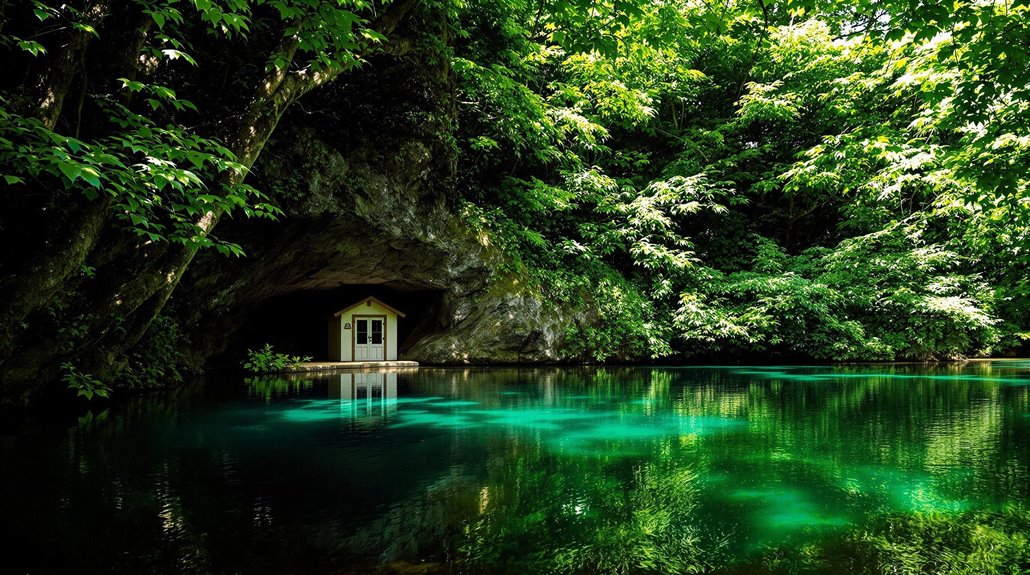How to Blend In: Choosing a Bug-Out Location That Doesn’t Draw Attention

To choose a bug-out location that doesn't draw attention, locate it over 50 miles from cities and use natural barriers like mountains or dense forests for cover and security. Opt for sites off main trails to guarantee privacy and integrate earth-toned materials and local foliage to camouflage shelters. Access multiple water sources and utilize surrounding timber for sustainability. Build discreet community ties and engage in local customs to avoid unwanted attention. Secure your site with sturdy shelters and natural fences. Balancing isolation with vital resources keeps your location low-profile and viable. There's more to learn about planning a seamless bug-out strategy.
Assessing Remote Accessibility
When you're evaluating remote accessibility for a bug-out location, focus on finding places that are at least a full gas tank away from urban areas, ideally beyond 50 miles. This distance minimizes your chances of encountering high population density during emergencies. Prioritize locations with natural barriers such as mountains, rivers, or dense forests. These features not only provide scenic beauty but also add a layer of security by impeding unwanted access, effectively protecting your hideout from potential threats. It's vital to scrutinize potential choke points along access routes. These can be essential for both entry and exit during a crisis. Confirm that your chosen bug-out location has at least two egress routes. This guarantees flexibility in your evacuation plans, allowing you to adapt quickly if one route becomes compromised. Research historical traffic patterns to pinpoint times when access routes may be less congested. Even remote areas might see increased foot or vehicle traffic during peak seasons or local events. Finally, aim for locations with defendable terrain, like raised areas or land with natural cover. This improves both visibility and security, making your bug-out location more secure. Additionally, ensure that the location has access to water purification methods to maintain a clean water supply during extended stays.
Natural Camouflage Strategies
After securing a bug-out location with remote accessibility, focus on blending seamlessly with the natural environment through effective camouflage strategies. Make sure your location is surrounded by dense vegetation or natural barriers like forests or hills. These features obscure visibility and reduce detection chances from both air and ground. Use earth-toned paints and fabrics for shelter construction to blend with the environment and avoid attracting unwanted attention.
Incorporate local foliage into your setup to create a camouflage effect. Use branches, leaves, and other natural elements to meld your shelter with the landscape. Avoid clearings or open spaces; instead, choose sites that offer natural cover while ensuring access to vital resources like water sources. This not only keeps you hidden but also provides what you need to sustain your stay.
To prevent detection, minimize noise and light pollution. Opt for solar or low-intensity lighting and conduct activities like cooking discreetly. This prevents drawing attention while you provide heat for survival. Security firms often overlook well-camouflaged sites, giving you an added layer of safety. By adhering to these strategies, you improve your bug-out location's security and longevity. Additionally, including solar-powered lanterns in your kit provides an eco-friendly and reliable light source that aligns with the need to minimize light pollution while ensuring visibility in emergencies.
Water and Resource Availability

Securing a reliable water supply is paramount when selecting a bug-out location, as it directly impacts your survival and daily needs, such as drinking, hygiene, and food preparation. Prioritize properties with multiple sources of water—like ponds, wells, or rivers—to improve sustainability. This variety reduces your reliance on external supplies and guarantees a steady flow even in emergencies. Here's how to efficiently manage water and resources:
- Assess Local Water Sources: Investigate small towns with nearby ponds or rivers. These areas often provide natural sources of water, which are fundamental for long-term survival.
- Verify Water Quality: Regularly monitor and evaluate your source of water to avoid contamination. Investing in water purification methods is critical for safe consumption.
- Maximize Food Storage: Supplement your survival kits with local foraging opportunities. Identifying edible plants and wildlife not only improves food storage but also maintains a low profile.
- Leverage Natural Resources: Utilize the surrounding timber and wildlife for extra food and shelter options. These resources are significant for sustaining yourself without drawing attention.
- Consider water filters meeting certification standards and having lower micron ratings for effective contaminant removal, as they will ensure a reliable and safe water supply during emergencies.
Shelter and Security Measures
Finding the right bug-out location means taking shelter and security measures seriously to guarantee you're well-protected. Begin by selecting a discreet shelter, ideally one that's off-road and not easily visible from main routes. This reduces the risk of detection by outsiders. Fortify your shelter with security measures like robust doors and windows equipped with secure shutters and deadbolts. These improvements make it difficult for intruders while maintaining a low profile.
To further blend in, establish a perimeter fence that utilizes natural barriers like trees or shrubs. This not only boosts security but also helps your shelter integrate seamlessly into the surrounding environment. Camouflage techniques are vital; consider painting visible structures in earth tones or using natural foliage to help them blend with the landscape. In addition, consider utilizing LED lanterns for lighting, as they offer superior energy efficiency and durability, which is crucial for maintaining low visibility and reducing the need for frequent maintenance.
Regular assessments of your shelter's visibility from different angles are fundamental. Ascertain that any outdoor equipment or supplies are stored out of sight, minimizing any potential threats. By taking these steps, you create a secure, inconspicuous bug-out location that not only protects you but also keeps you under the radar, effectively merging with the natural terrain.
Utilizing Federal Land Options

One viable strategy for securing a discreet bug-out location is utilizing federal land options, like National Forests and Parks, which often permit dispersed camping for up to 14 days. These areas offer a retreat from urban areas, enhancing your privacy with their lower population densities. However, it's essential to research and understand the rules for camping and land use to guarantee compliance with local regulations. Here's how you can make the most of federal land as a bug-out location:
- Scouting: Before you need to bug out, scout potential locations. Look for water sources, natural barriers, and defensible positions that suit your needs.
- Passes and Permits: Consider obtaining an annual or lifetime pass to federal parks. This not only eases access but also allows for longer stays without drawing unwanted attention.
- Regulation Awareness: Familiarize yourself with the specific rules of the federal land you plan to use. This includes understanding stay limits, fire regulations, and other use guidelines.
- Avoiding Detection: Choose sites that are off main trails and roads to minimize the chance of being seen. This helps maintain security and privacy during your stay.
- Community Dynamics: Engaging with local support networks can provide valuable insights and assistance while maintaining discretion in your plans.
Community and Support Networks
Building a network of trusted individuals can greatly improve your preparedness and resilience in emergencies. A well-rounded community and support networks provide strength in numbers, allowing you to pool resources and knowledge. When you live in an area where you can rely on others, you increase your chance of survival. By connecting with people who have diverse skills, from medical expertise to mechanical know-how, you guarantee a more thorough approach to emergency situations. Engage with local prepper communities to share equipment and supplies, so you're better equipped to handle unforeseen circumstances. This collaboration not only amplifies your resource pool but also opens up alternative routes for obtaining necessities when traditional avenues fail. Furthermore, fostering relationships with local law enforcement can give you insights into potential threats and effective bug-out strategies. Organize discreetly with your support network to keep your plans confidential and prevent unwanted attention. Establishing trust and reliability within your community is vital for long-term sustainability and safety. When everyone in your network is committed to mutual aid, you create a solid foundation that improves both individual and collective resilience in crisis scenarios. In addition to local networks, consider the importance of emergency signaling devices to communicate effectively and call for help when necessary.
Blending With Local Populations

Many people overlook the importance of blending with local populations while choosing a bug-out location. By integrating yourself into the local community, you reduce your chances of drawing unwanted attention. Here are some effective strategies:
- Engage in Local Customs: Take the time to learn and participate in local customs. This might involve attending community events or using regional terminology. By doing so, you show respect and interest, which helps foster positive relationships with your neighbors.
- Maintain a Low Profile: It's essential to keep a low profile. Avoid flaunting wealth with expensive vehicles or flashy security systems that could make your property stand out. The goal is to remain unnoticed among the locals.
- Blend with the Environment: Choose a property that uses neutral colors and designs. This helps your residence blend with the natural surroundings, keeping it from catching the attention of passersby or neighbors.
- Adapt to Social Norms: Understanding and adapting to the local culture and social norms is vital. When you appear to be part of the community, others are less likely to scrutinize or question your presence. Engaging in community support activities, such as joining local prepper groups, can build trust and resilience, enhancing your integration into the area.
Sustainable Living Practices
When choosing a bug-out location, embracing sustainable living practices isn't just environmentally responsible—it's essential for self-reliance. Implementing permaculture principles can create a self-sustaining ecosystem that efficiently uses natural resources, minimizing the need for external inputs. Start by setting up a rainwater harvesting system to secure a reliable water source. This reduces your dependence on municipal supplies and enhances self-sufficiency during emergencies.
Cultivating a diverse range of crops, including heirloom and native plants, is important for improving soil health. This diversity strengthens resilience against pests and diseases, guaranteeing a stable food supply. Furthermore, integrating renewable energy sources, such as solar panels or wind turbines, can greatly decrease your reliance on fossil fuels, promoting long-term sustainability in your bug-out location.
Establishing a composting system is another key step. It reduces waste while enriching soil fertility, supporting productive gardens, and maintaining a low environmental footprint. By adopting these sustainable living practices, you can create a harmonious and resilient environment. This not only supports your immediate needs but also guarantees that your bug-out location remains viable and self-sufficient in the long term, offering peace of mind in unpredictable times. Consider growing carrots and potatoes as they provide high yields and store well, enhancing your food security in a survival garden.




